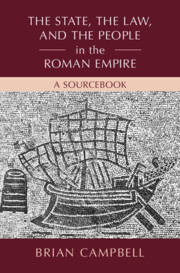Refine listing
Actions for selected content:
1295948 results in Books
Copyright page
-
- Book:
- Empire of Fear
- Published online:
- 27 November 2025
- Print publication:
- 11 December 2025, pp iv-iv
-
- Chapter
- Export citation
Acknowledgments
-
- Book:
- Representing Relationships
- Published online:
- 21 November 2025
- Print publication:
- 11 December 2025, pp xii-xiv
-
- Chapter
- Export citation
6 - Regulatory Reforms and the Rise of the Saudi Impact Sector
- from Part II - Capacity Building
-
-
- Book:
- Catalytic Capital
- Published online:
- 27 November 2025
- Print publication:
- 11 December 2025, pp 134-149
-
- Chapter
-
- You have access
- Open access
- HTML
- Export citation
Chapter 27 - Legal Issues in Dementia
- from Section 3 - Treatment of the Dementias
-
-
- Book:
- The Behavioral Neurology of Dementia
- Published online:
- 17 November 2025
- Print publication:
- 11 December 2025, pp 466-482
-
- Chapter
- Export citation
Copyright page
-
- Book:
- American Performance in 1976
- Published online:
- 27 November 2025
- Print publication:
- 11 December 2025, pp iv-iv
-
- Chapter
- Export citation
Copyright page
-
- Book:
- Theatre as Technology
- Published online:
- 27 November 2025
- Print publication:
- 11 December 2025, pp iv-iv
-
- Chapter
- Export citation
Bibliography
-
- Book:
- Empire of Fear
- Published online:
- 27 November 2025
- Print publication:
- 11 December 2025, pp 318-340
-
- Chapter
- Export citation
9 - Australian Poetries of War and Conflict
-
-
- Book:
- The Cambridge History of Australian Poetry
- Published online:
- 19 November 2025
- Print publication:
- 11 December 2025, pp 169-187
-
- Chapter
- Export citation
2 - British Speculations on Terra Australis and Romantic-Period Poetry
-
-
- Book:
- The Cambridge History of Australian Poetry
- Published online:
- 19 November 2025
- Print publication:
- 11 December 2025, pp 47-62
-
- Chapter
- Export citation
Introduction: “An Imaginary Knowledge of the Perfect Truth” Meets the Risk-Uncertainty Conundrum
-
- Book:
- Entanglements in World Politics
- Published online:
- 27 November 2025
- Print publication:
- 11 December 2025, pp 1-30
-
- Chapter
-
- You have access
- Open access
- HTML
- Export citation
Money and Measures
-
- Book:
- The Power of Peasant Consumers
- Published online:
- 27 November 2025
- Print publication:
- 11 December 2025, pp xv-xv
-
- Chapter
- Export citation
Index
-
- Book:
- Empire of Fear
- Published online:
- 27 November 2025
- Print publication:
- 11 December 2025, pp 341-355
-
- Chapter
- Export citation
Contents
-
- Book:
- Fundamentals of Translation
- Published online:
- 04 December 2025
- Print publication:
- 11 December 2025, pp vii-x
-
- Chapter
- Export citation
References
-
- Book:
- The Philosophy of Antoine Arnauld
- Published online:
- 27 November 2025
- Print publication:
- 11 December 2025, pp 265-286
-
- Chapter
- Export citation
Chapter 22 - Treatment of Frontotemporal Dementias
- from Section 3 - Treatment of the Dementias
-
-
- Book:
- The Behavioral Neurology of Dementia
- Published online:
- 17 November 2025
- Print publication:
- 11 December 2025, pp 373-386
-
- Chapter
- Export citation
Notes
-
- Book:
- Irish Romanticism
- Published online:
- 27 November 2025
- Print publication:
- 11 December 2025, pp 182-217
-
- Chapter
- Export citation
Introduction
-
-
- Book:
- The Cambridge History of Australian Poetry
- Published online:
- 19 November 2025
- Print publication:
- 11 December 2025, pp 1-24
-
- Chapter
- Export citation
Contents
-
- Book:
- The Behavioral Neurology of Dementia
- Published online:
- 17 November 2025
- Print publication:
- 11 December 2025, pp v-vi
-
- Chapter
- Export citation
References
-
- Book:
- Entanglements in World Politics
- Published online:
- 27 November 2025
- Print publication:
- 11 December 2025, pp 358-446
-
- Chapter
-
- You have access
- Open access
- HTML
- Export citation

The State, the Law, and the People in the Roman Empire
- A Sourcebook
- Coming soon
-
- Expected online publication date:
- December 2025
- Print publication:
- 11 December 2025
-
- Book
- Export citation
